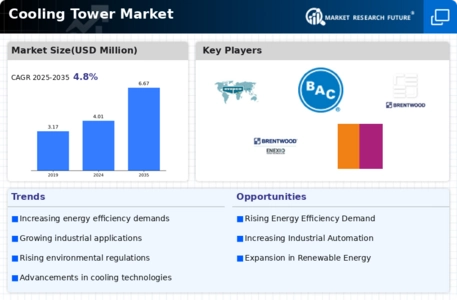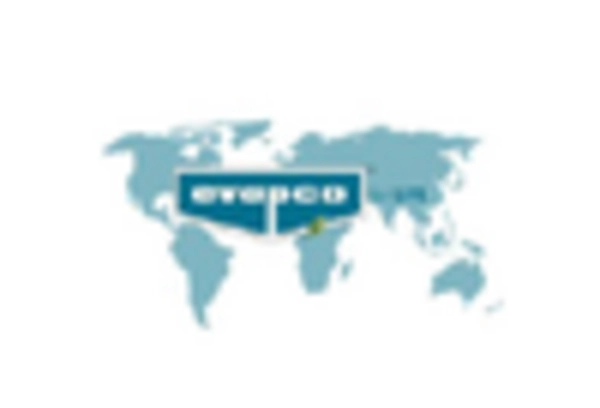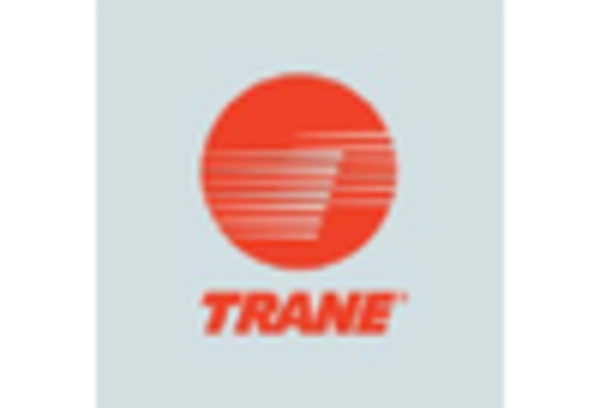Increased Focus on Sustainability
The heightened focus on sustainability is a driving force in the Cooling Tower Market. As organizations prioritize sustainable practices, the demand for eco-friendly cooling solutions is on the rise. Cooling towers that utilize renewable energy sources or have lower environmental footprints are becoming increasingly popular. This trend is supported by consumer preferences shifting towards sustainable products and practices. Additionally, industries are recognizing the long-term benefits of investing in sustainable cooling technologies, which can lead to cost savings and improved corporate image. The emphasis on sustainability is likely to continue influencing purchasing decisions, thereby propelling the growth of the Cooling Tower Market.
Industrial Growth and Urbanization
The rapid pace of industrial growth and urbanization significantly influences the Cooling Tower Market. As urban areas expand and industries proliferate, the need for effective cooling solutions becomes increasingly critical. Data suggests that the industrial sector, particularly in manufacturing and power generation, is a major consumer of cooling towers, accounting for a substantial share of the market. The construction of new facilities and the expansion of existing ones necessitate the installation of cooling systems to manage heat loads effectively. This trend is expected to continue, with projections indicating a steady increase in demand for cooling towers in urbanized regions. The Cooling Tower Market is thus poised for growth, driven by the ongoing industrialization and urban development.
Rising Demand for Energy Efficiency
The increasing emphasis on energy efficiency is a primary driver for the Cooling Tower Market. As industries strive to reduce operational costs and minimize environmental impact, energy-efficient cooling solutions are becoming essential. According to recent data, energy-efficient cooling towers can reduce energy consumption by up to 30% compared to traditional models. This shift not only aligns with sustainability goals but also meets regulatory requirements in various regions. Consequently, manufacturers are innovating to produce cooling towers that utilize advanced materials and designs, enhancing their efficiency. The growing awareness of energy conservation among consumers and businesses alike further propels the demand for these systems, indicating a robust growth trajectory for the Cooling Tower Market.
Technological Innovations in Cooling Solutions
Technological innovations play a crucial role in shaping the Cooling Tower Market. The advent of new materials, designs, and control systems has led to the development of more efficient and reliable cooling towers. Innovations such as variable speed drives, advanced heat exchangers, and smart monitoring systems enhance the performance and efficiency of cooling towers. These technologies not only improve energy efficiency but also extend the lifespan of cooling systems. Furthermore, the integration of IoT and automation in cooling tower operations allows for real-time monitoring and optimization, reducing maintenance costs and downtime. As industries increasingly adopt these advanced technologies, the Cooling Tower Market is expected to witness significant advancements and growth.
Regulatory Compliance and Environmental Standards
The stringent regulatory compliance and environmental standards are pivotal drivers for the Cooling Tower Market. Governments worldwide are implementing regulations aimed at reducing water and energy consumption, as well as minimizing emissions from industrial processes. These regulations compel industries to adopt advanced cooling technologies that comply with environmental standards. For instance, cooling towers that utilize closed-loop systems are gaining traction due to their reduced water usage and lower environmental impact. The need for compliance not only drives the demand for innovative cooling solutions but also encourages manufacturers to invest in research and development. As industries seek to meet these regulatory requirements, the Cooling Tower Market is likely to experience sustained growth.


















Leave a Comment